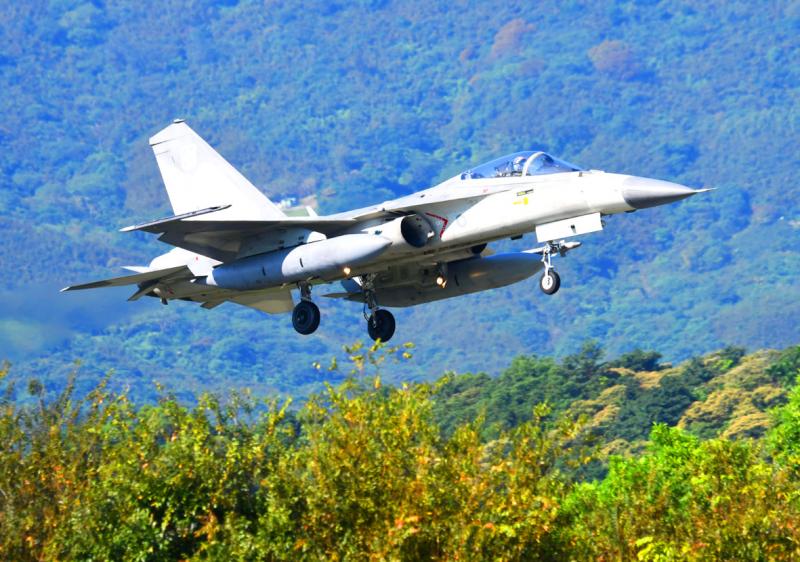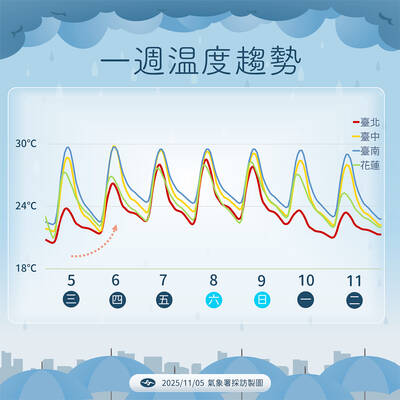A successful attempt by the Chungshan Institute of Science and Technology to develop external pods for the nation’s locally made fighter jets would allow the military to shore up its electronic warfare capability, a military source said yesterday.
Development of the external pods would address the Taiwan-made Indigenous Defense Fighter’s (IDF) lack of electronic warfare capabilities, the source said, adding that dependable pods would considerably enhance the fighter jets’ combat effectiveness.
Larger fighter jets — such as the F-16Vs that Taiwan is purchasing from the US — come with such equipment built in, the source added.

Photo: Yu Tai-lang, Taipei Times
The IDF’s narrower frame cannot accommodate the electronics, so the military commissioned the institute to design an indigenous external pod.
Also, the number of companies that supply radar warning receivers has been dwindling.
The air force’s Phoenix Rising Project has purchased external pods with digital radio frequency memory for the nation’s fleet of F-16A/B jets, which are receiving F-16V upgrades — a source of controversy.
The Control Yuan in 2018 told the Republic of China Air Force Command Headquarters to improve its protocols for purchasing equipment.
However, the pod development might encounter obstacles regarding US research and development on new pods, the source said.
Delivery of the 66 F-16Vs would not be affected, but the US is reassessing the functionality and overhead cost of the F-16V’s electronic warfare suite, Air Force Command Headquarters said on March 21, adding that it would consider purchasing any add-ons or making other changes within the guidelines of the Special Act for New Fighter Acquisition (新式戰機採購特別條例及預算).

UNILATERAL MOVES: Officials have raised concerns that Beijing could try to exert economic control over Kinmen in a key development plan next year The Civil Aviation Administration (CAA) yesterday said that China has so far failed to provide any information about a new airport expected to open next year that is less than 10km from a Taiwanese airport, raising flight safety concerns. Xiamen Xiangan International Airport is only about 3km at its closest point from the islands in Kinmen County — the scene of on-off fighting during the Cold War — and construction work can be seen and heard clearly from the Taiwan side. In a written statement sent to Reuters, the CAA said that airports close to each other need detailed advanced

Tropical Storm Fung-Wong would likely strengthen into a typhoon later today as it continues moving westward across the Pacific before heading in Taiwan’s direction next week, the Central Weather Administration (CWA) said. As of 8am, Fung-Wong was about 2,190km east-southeast of Cape Oluanpi (鵝鑾鼻), Taiwan’s southernmost point, moving westward at 25kph and possibly accelerating to 31kph, CWA data showed. The tropical storm is currently over waters east of the Philippines and still far from Taiwan, CWA forecaster Tseng Chao-cheng (曾昭誠) said, adding that it could likely strengthen into a typhoon later in the day. It is forecast to reach the South China Sea

WEATHER Typhoon forming: CWA A tropical depression is expected to form into a typhoon as early as today, the Central Weather Administration (CWA) said yesterday, adding that the storm’s path remains uncertain. Before the weekend, it would move toward the Philippines, the agency said. Some time around Monday next week, it might reach a turning point, either veering north toward waters east of Taiwan or continuing westward across the Philippines, the CWA said. Meanwhile, the eye of Typhoon Kalmaegi was 1,310km south-southeast of Oluanpi (鵝鑾鼻), Taiwan’s southernmost point, as of 2am yesterday, it said. The storm is forecast to move through central

UNKNOWN TRAJECTORY: The storm could move in four possible directions, with the fourth option considered the most threatening to Taiwan, meteorologist Lin De-en said A soon-to-be-formed tropical storm east of the Philippines could begin affecting Taiwan on Wednesday next week, the Central Weather Administration (CWA) said yesterday. The storm, to be named Fung-wong (鳳凰), is forecast to approach Taiwan on Tuesday next week and could begin affecting the weather in Taiwan on Wednesday, CWA forecaster Huang En-hung (黃恩鴻) said, adding that its impact might be amplified by the combined effect with the northeast monsoon. As of 2pm yesterday, the system’s center was 2,800km southeast of Oluanbi (鵝鑾鼻). It was moving northwest at 18kph. Meteorologist Lin De-en (林得恩) on Facebook yesterday wrote that the would-be storm is surrounded by